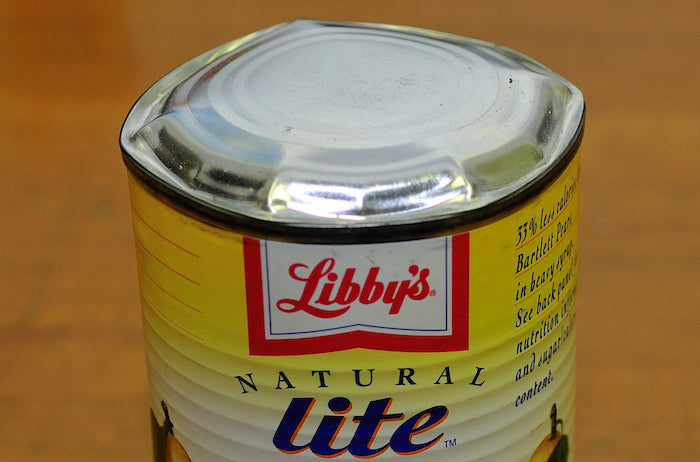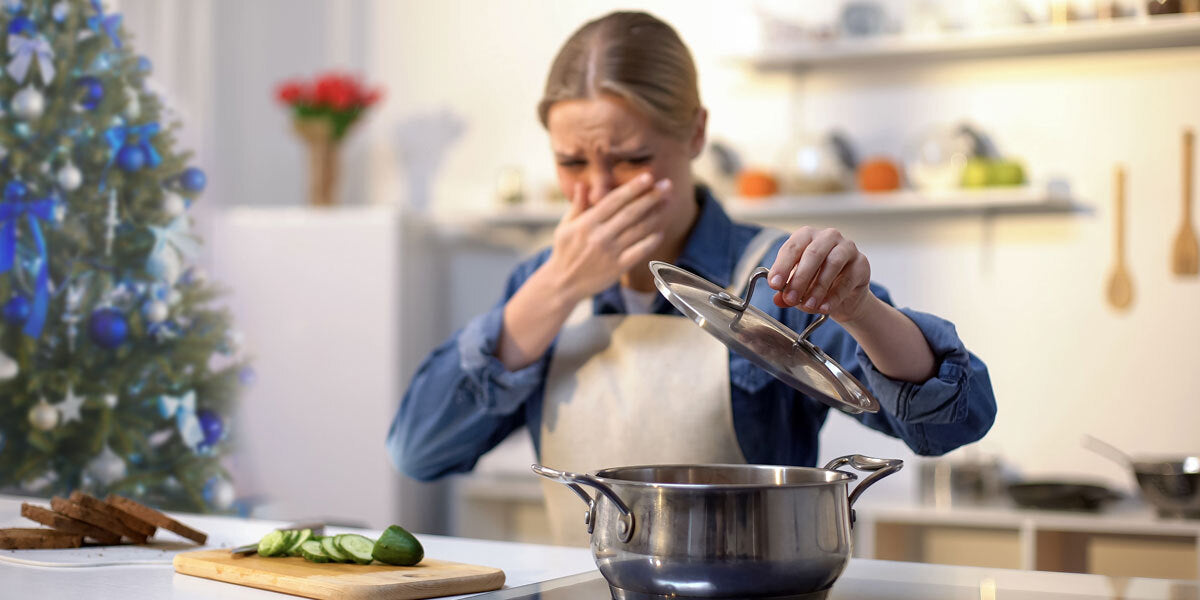Expired ingredients can ruin a perfectly good meal!
During everyday life, when you can just run down to the grocery store and pick up anything you need, that’s not a huge deal.
During an emergency though, when there’s not much food to go around, a ruined meal can present a FUNDAMENTAL threat to your safety.
But don’t worry, we’re here to help. Today we’re going to show you five quick and easy tricks to test whether common ingredients like baking soda, spices, and canned goods have spoiled…before you use them.
By the way, these tricks are SUPER handy during Christmas, too! They’ll help ensure everything that comes out of your kitchen is perfect.
1. Yeast

Testing if yeast has spoiled requires just a little water and yeast.
Yeast is the magical ingredient that that makes bread so wonderfully fluffy.
It’s also a great ingredient to have on hand for emergencies. There’s nothing like bread to put a smile on your face. In fact, a recent study found that 89% of people report that just the smell of bread makes them happy. You can hardly put a price tag on that.
HOW TO TEST YEAST: ADD SUGAR AND WATER
Yeast has about a four-to-six-month shelf life. Beyond that time frame, it will no longer reliably cause bread to rise.
Luckily, “proofing” your yeast for potency is easy:
- Add one teaspoon of sugar and one-quarter cup warm water
- Mix in two or three teaspoons of yeast
- Wait 10 minutes. If you see bubbles, your yeast is still good.
HOW THE TEST WORKS: YEAST EATS SUGAR
The bubbles you see in the test are carbon dioxide—which is what causes the yeast to rise. If that’s present, then your yeast is good. That carbon dioxide is a byproduct of single-celled organisms called Saccharomyces (otherwise known as yeast) feeding on the sugar. Once those little guys die, your yeast “expires.”
HOW TO PREVENT SPOILAGE: TOSS IT IN THE FREEZER
To get more life out of your yeast, store it in a cool, dry place—that will stretch its usefulness out a few months. If you put it unopened into the freezer, though that figure shoots up to two years!
2. Baking Soda

A combination of vinegar and baking soda can tell you whether the soda has gone bad.
As the other major leavening ingredient in Western foods (besides yeast), you’ll find baking soda in countless recipes. It’s super versatile, even beyond cooking; it’s great for scrubbing dirty surfaces, freshening up stinky odors, and relieving sunburns…a strong addition to any emergency supply.
HOW TO TEST BAKING SODA: MIX WITH A FEW PARTS VINEGAR
But all that usefulness depends on baking soda’s robust leavening action, which it loses over time or when exposed to acidic moisture.
To test whether your baking soda still has “pop”:
- Pour a few tablespoons of vinegar into a bowl
- Add a teaspoon of soda and stir
If you see an immediate fizzing reaction, your baking soda is still good. If not, it’s time to toss it out.
HOW THE TEST WORKS: TRANSFORM VINEGAR INTO WATER AND CARBON DIOXIDE
Simply put, the baking soda is grabbing the elements in the vinegar and converting them into water and carbon dioxide, which combine to create a “fizzing” effect. That reaction changes the chemical structure of the baking soda, and once it’s transformed, its potency is lost.
HOW TO PREVENT SPOILAGE: KEEP IT WATERTIGHT AND IT CAN LAST INDEFINITELY
Baking soda is tough stuff—it can basically last forever if it’s not exposed to moisture. To extend its shelf life, keep your baking soda in a cool, dry place and sealed in a watertight container.
Related Article: How to Make Bread without Yeast or Oil
3. Eggs

Does your egg float? If so, you're better off throwing it out.
The food that needs no introduction! Eggs are versatile, and even better, they’re packed with high-quality protein. This makes them one of the quickest, most efficient energy sources you can find.
HOW TO TEST AN EGG: SEE IF IT FLOATS
When eggs go bad, they let off that famous smell. But even eggs without an odor can be very close to rotten. If you ever have a question about the state of your eggs, here are a couple tricks that can save your stomach a lot of misery:
If you just want to see how old an egg is, place it on a flat surface and step back. If it tilts so the large end is facing up, that means it’s getting old and may not last much longer.
Put the egg into a bowl of cold water. If it floats, it’s time toss it out. If it sinks to the bottom, it’s edible.
HOW THE TEST WORKS: GAS BUBBLES—YUCK!
Basically, raw eggs go bad because the fluid inside them slowly evaporates through the porous shell, letting in oxygen and gas in its place. Older eggs hold more gasses—hence the floating (and the smell).
HOW TO PREVENT SPOILAGE: SWITCH TO DEHYDRATED
There are a few tried-and-true methods to extend the shelf life of an egg, from “liming” to pickling, and more. While these are all great, they do require a bit of effort and know-how to pull off. And let’s be honest: not everyone loves the taste of pickled eggs.
Our recommendation? Get dehydrated eggs instead. They last 10 years or more and taste exactly like fresh eggs; most people can’t tell the difference.
4. Spices

Crushing or rubbing spices into your hand will help bring the odor forward and show you whether they've lost their potency.
Trust us when we say, your spice rack can really come in handy during an emergency. Not only do those spices make foods tastier, they also have tons of alternative uses that can save you in an emergency.
For example:
- Ginger can alleviate nausea
- Chili powder repels insects
- Cayenne pepper makes a defensive pepper spray
- Cinnamon can help alleviate stomach pain
And that’s just getting started.
But your spices need to be fresh and pungent for any of this to work. Once they’ve gone flat, they’ll only do half the job.
HOW TO TEST SPICES: SMASH AND SNIFF
Rather than just sniffing your spices to tell whether they’re good, try crushing or rubbing a small amount in your hand first. If the scent is faint or too mild, you know it’s time for a replacement.
HOW THE TEST WORKS: COMPOUNDS RELEASED
Crushing your spices releases the compounds that create scents (capsaicin in cayenne pepper, cinnamaldehyde in cinnamon, etc.). It turns the odor “up to 11,” so to speak, and gives you a more nuanced feel for their aromas.
HOW TO PREVENT SPOILAGE: GLASS OR METAL JARS
Our experts recommend using glass or metal jars to store your spices, rather than plastic ones. Glass and metal are less porous and let in less oxygen, which is the ultimate shelf-life killer.
5. Canned Foods

A swollen can means the food inside has gone bad, but it's far from the only sign of spoilage.
Canned foods are the backbone of many an emergency supply, but as we know, they can harbor the deadly bacterium botulism. Knowing the signs of spoilage can literally save your life
HOW TO TEST CANNED FOODS: KNOW THE SIGNS
These are the most common signs of spoilage in canned foods. Get to know them:
- Swelling anywhere on the can
- Spurting liquid that jumps out when you open the can or jar
- Bubbles in the food (these are gasses and tend to move upward)
- Foul odors
- Cloudy food—liquid that’s no longer clear or transparent
- Oozing food, usually coming from the lid
- Mushy food
- Mold in food
- Corrosion, like rust
Always watch the “best by date” and FOLLOW YOUR GUT, even if there are no obvious signs of spoilage. It’s better to toss a $1.50 can of food in the trash than risk a major medical emergency.
Related Article: Preparedness Showdown! Emergency Food vs. Grocery Store Food
HOW TO PREVENT SPOILAGE: SWITCH TO DEHYDRATED AND FREEZE-DRIED FOOD
Like we said, there are basic tricks that can extend the shelf life of canned food, but why go to all the trouble?
Our advice is to replace as many of your canned foods as possible with their dehydrated or freeze-dried counterparts. They’ll be healthier; better tasting; and last many, many times longer.
And while dehydrate and freeze-dried foods do have a larger up-front cost, they nearly always pay you back as the years go by.
Image Credits:
"Death in a can?" by Peter Baer is licensed under CC BY-NC-SA 2.0. To view a copy of this license, visit https://creativecommons.org/licenses/by-nc-sa/2.0/?ref=openverse&atype=rich


1 comment
Nina Joyce Matheny
I learned a lot and renewed my knowledge of food to eat and how to survive some very
pleasant situations.